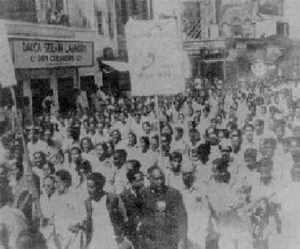
The 1961 Bengali Language Movement in Southern Assam is a poignant chapter in Indian history that embodies the fight for rights to language and culture. This movement, which has its roots in the nation’s diverse fabric, developed in the context of linguistic diversity and the desire for regional autonomy. Primarily home to Bengali-speaking communities, the Southern Assam region of Barak Valley served as the backdrop for a movement aimed at protecting the linguistic identity of its people. The Bengali Language Movement’s historical background, happenings, and effects in Southern Assam demonstrate how tenacious a community can be in defending its linguistic and cultural rights.
Following India’s 1947 partition, Bengali-speaking Muslims were given their own nation when East Pakistan, or modern-day Bangladesh, was established. However, the region of Barak Valley, despite its predominantly Bengali-speaking population, remained a part of Assam, a state where Assamese was the official language. This linguistic disparity laid the foundation for discontent and sowed the seeds for the Bengali Language Movement.
In 1960 when Bimala Prasad Chaliha, the Chief Minister of Assam at the time, presented a bill in the state assembly seeking to declare Assamese the only official language of the state. The bill was opposed by Karimganj legislator Ranendra Mohan Das on the grounds that it was equivalent to imposing the language of one third on the rest of the population since Assam included ethnic groups from the modern-day states of Arunachal Pradesh, Nagaland, Mizoram, Manipur and Meghalaya in addition to Bengalis. Once the contentious bill was passed, it added fuel to the fire, causing Bengal Kheda to erupt across the Brahmaputra Valley and resulting in a horrific massacre of Bengali Hindus in Goreswar.

The 1961 Bengali Language Movement in Barak Valley was marked by nonviolent demonstrations, assemblies, and acts of civil disobedience. Students, intellectuals, and regular people made up the protestors who took to the streets to express their worries and call for linguistic equality. The formation of the ‘Bhasha Suraksha Samiti’ (Language Protection Committee), a forum that brought together disparate Bengali-speaking communities around a shared goal, gave the movement impetus.
The tragic events of May 19, 1961, when the police opened fire on a peaceful demonstration in Silchar, resulting in several casualties, marked a turning point in the agitation. The movement was energised by the lives lost, which brought the suffering of the Bengali-speaking community to light and heightened the demand for linguistic rights.
The government was forced to address the complaints of the Bengali-speaking community due to growing protests and public outcry. The Assam government addressed the matter after realising the importance of linguistic harmony. Bengali was added as an official language in Barak Valley as per Section 5 of Assam Act XVIII, 1961 for the three districts of Southern Assam that have a Bengali majority. Even though it was a huge victory, the linguistic dispute was only partially resolved by this point.

The socio-political climate of Southern Assam has been permanently altered by the Bengali Language Movement. It promoted a sense of identity and solidarity among the Bengali-speaking community in addition to securing linguistic rights for them. In the face of language discrimination, the movement showed the strength of nonviolent resistance and group action.
The 1961 events had a long-lasting effect on the region’s linguistic laws. They sparked a more welcoming attitude toward linguistic diversity by highlighting how crucial it is to identify and protect the languages used by the many communities that make up the Indian subcontinent.
The Bengali Language Movement of 1961 is evidence of the community’s tenacity in defending its linguistic and cultural rights. Bengali was granted a position as an associate official language by the movement, which was born out of a fight against linguistic imposition. It also became a symbol of identity and unification. The events of 1961 serve as a reminder of the significance of defending the linguistic and cultural rights of all Indian citizens, regardless of their linguistic affiliations, as the country continues to celebrate its linguistic diversity.

